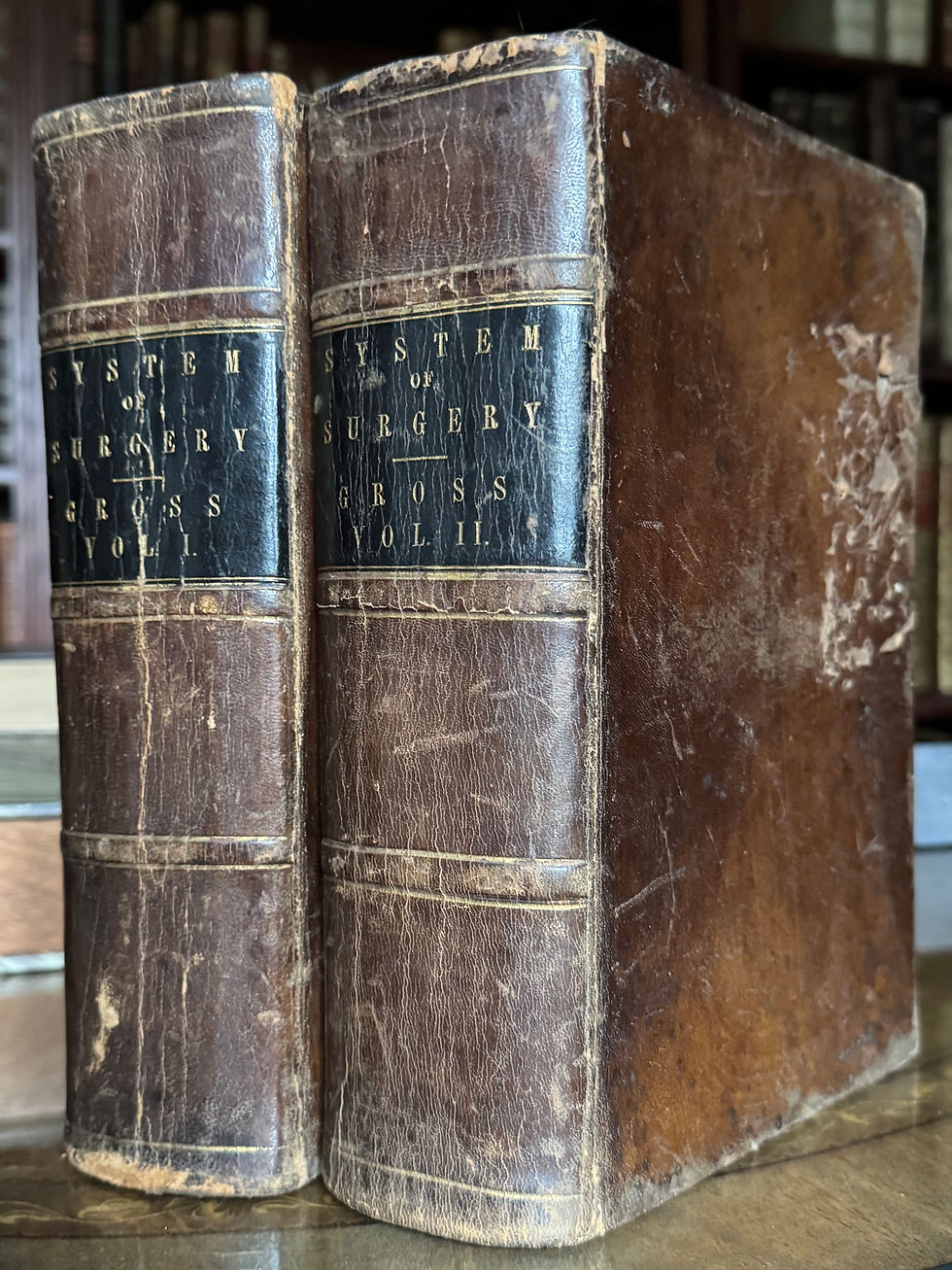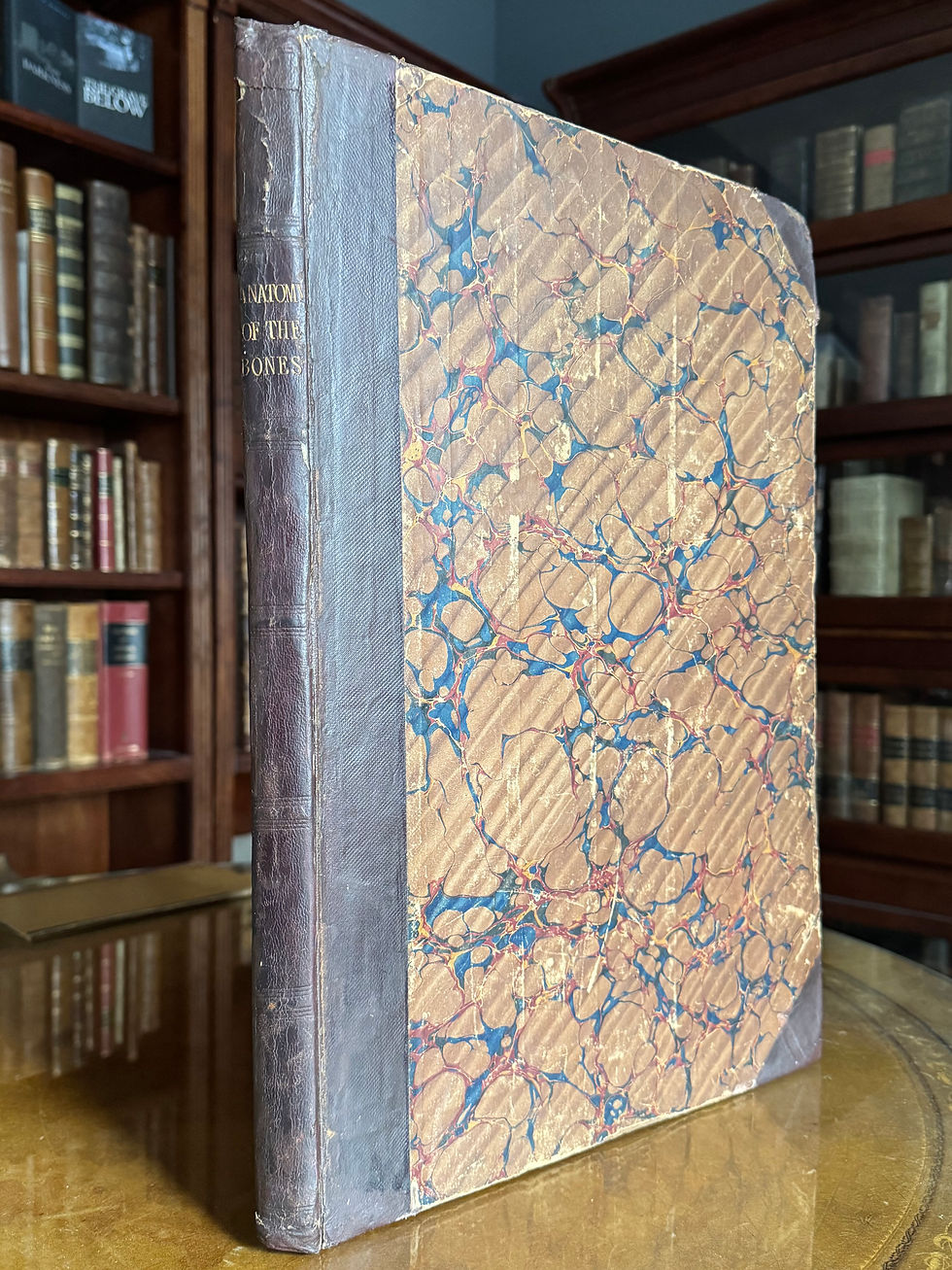Albinus, Explicatio Tabularum Anatomicarum Bartholomaei Eustachii, 1761
Bernardi Siegfried Albini Explicatio Tabularum Anatomicarum Bartholomaei Eustachii, Anatomici Summi. Auctor recognovit, castigavit, auxit, denuo edidit. Leidae, 1761.
Full brown mottled (“cat’s paw”) leather folio with six raised bands, red title plate, and gold detailing on spine. Marbled end papers and red page edges. Title page in red and black ink. Ex library book plate on front paste down and white ink library alphanumeric code written at bottom of spine. Occasional library stamp in margins on some pages. Corners bumped and chipped. Large portion of leather absent from top of front board. Front hinge cracking at top and bottom, rear hinge cracking at top, but boards still securely attached. Scattered mild damp stain at bottom corner on some leaves but mostly fresh and clean. Table XI rather browned. Binding tight. Plates printed on one side of each leaf (such that they could have been hung as posters in an 18th century university cadaver lab, which, indeed, seems to have been the fate of many similar anatomic folios over the centuries). A good to very good copy.
Ffep, half title, full title, 4 pg Epistola, 25 pages Praefatio, 1 pg Ad Excellentissimum, 2 pages (G2) De Usu Tabularum, G3 – Dd dd 2 Tables with Explicatio (47 tables, 261 pgs), 1 pg Bibliopego, fly leaf.
We note here some of our own observations based on experience in cadaver dissection:
The overall organization of the book is by systems, however regional anatomy can also be gleaned, with many plates demonstrating the spatial relations of viscera, neurovasculature, and musculoskeletal structures. Table XVIII, for example, is the famous central nervous system with spine and plexuses. The relationship of neuroanatomy to the spinal column is ably demonstrated. The kidney is bivalved and the cardiac chambers opened longitudinally through the atrioventricular valves—dissections familiar to 21st century pathologists. Table XXXV demonstrates the bony pelvis in a far more accurate position than shown in Vesalius’ De Humani Corporis Fabrica (Vesalius having the pelvis rotated posteriorly such that the anterior superior iliac spines are not in the same vertical plane as the pubic tubercles—as they should be in life, and are shown more closely so here in Eustachius’ plates). Comparative vertebrate anatomy is also included. Table XXXXVI demonstrates the skull of a lower primate compared with that of the human. Artistic interpretation is not omitted however, as Table XXXIX illustrates a torso with arms which morphs seamlessly with an architectural pedestal below the pelvis.
Eustachius (now famous for the Eustachian tube in the ear) was a 16th century anatomist who was a contemporary of Andres Vesalius. It is general consensus that Eustachius’ anatomy was more accurate than Vesalius, but the work remained unfinished until 1552 (and unpublished until 1714, Garrison-Morton 1312 391 and Waller 337, as they were somewhat entombed in the Vatican Library until then). Vesalius published his De Humani Corpora Fabrica Libri Septem in 1543, making him the so-called father of anatomy. Bernhard Siegfried Albinus was a Dutch Anatomist who studied under Boerhaave and Bidloo, as well as Winslow.
“Having a great attachment for Galenic anatomy and defending it most vigorously against newer investigations, particularly those of Vesalian anatomy, Eustachius, more than any other anatomist of his time, enriched his science by exact investigations, which he extended to almost all parts of the human body. Moreover, he utilized animal dissections for pathological research an is said to have been the first anatomist to introduce postmortem examinations in Roman hospitals. His illustrations are dry and hard and show little artistic treatment, As modes of anatomic representation, they are exact and instructive and all are copper engravings. Instead of printing letters on the figures, which he everywhere avoids, Eustachius introduced graduated margins (similar to the margins of maps) which made possible the finding of any parts of their names by means of a ruler” (Choulant, pg 200).
“Eustachius resembled Leonardo in that his anatomical achievement was very much greater than the influence which he exerted.... For purposes of study, the edition issued...with the legends of B. S. Albinus is perhaps more valuable. Had these plates of Eustachius appeared in 1552, when completed, his name would have stood by the side of Vesalius as one of the founders of modern anatomy. The plates of Eustachius are less beautiful than those of Vesalius. … They are, however, more accurate.... His treatment of the kidney introduced the study of anatomical variations. The subject was hardly considered till modern times, but Eustachius applies it to many other parts.... Eustachius displays quite correctly the relations of the vein, artery, and bronchus in the lung in a manner which was not even attempted by Vesalius. …the glory of the whole Eustachian collection is a truly magnificent drawing of the Sympathetic System. … It is a really great anatomical figure, and is by itself sufficient to place Eustachius in the front rank of anatomists. The same remarkable figure shows the base of the brain, with the roots of the cranial nerves far more clearly and accurately rendered than by Vesalius. The pons, too, is shown better than by Varolius, whose name is now attached to it.” (Singer 135 – 140).
Heirs of Hippocrates 203 (re: the 1744 edition): “the plates are newly engraved by the artist Wandelaer and nearly all are accompanied by outline drawings, making a total of eighty-nine full-page plates. Albinus has added his own extensive descriptions and commentaries.” See also 199” “At first a Galenist in his teaching in Rome but later an adherent to the “new school,” Eustachi was the first to describe the Eustachian tube, the adrenal glands, the thoracic duct, and many of the finer structures of the teeth.” And see 525: “Albinus, a native of Frankfurt, was no doubt the finest descriptive anatomist of his day, and his works were especially endowed by the artistic copper engravings by the renowned Jan Wandelaer. He was a pupil of Bidloo, Rau, and Boerhaave.”
Bernhard Siegfried Albinus (1697 – 1770) lectured on anatomy at Leyden. “He was the pioneer of a new epoch in human anatomy, an epoch during which all investigations, an especially those pertaining to osteology and myology, were carried out with the most perfect thoroughness and exactitude and with all the means then available. Anatomic representation, too, enters upon an epoch of high perfection during which the mere outward appearance, superficial investigations, or the mere copying of subjects observed prove insufficient.” (Choulant 276).
















